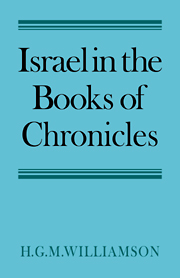Book contents
- Frontmatter
- Contents
- Foreword
- List of Abbreviations
- 1 Introduction
- PART ONE The Extent of the Chronicler's Work
- 2 2 Chronicles 36: 22f. and Ezra 1: 1–3a
- 3 The Evidence of the Greek Versions
- 4 Vocabulary and Style in Chronicles, Ezra and Nehemiah
- 5 Ideology
- 6 The Start of the Chronicler's Work
- PART TWO The Concept of Israel in the Books of Chronicles
- Bibliography
- Index of Passages Cited
- Index of Modern Authors
- General Index
4 - Vocabulary and Style in Chronicles, Ezra and Nehemiah
Published online by Cambridge University Press: 26 February 2010
- Frontmatter
- Contents
- Foreword
- List of Abbreviations
- 1 Introduction
- PART ONE The Extent of the Chronicler's Work
- 2 2 Chronicles 36: 22f. and Ezra 1: 1–3a
- 3 The Evidence of the Greek Versions
- 4 Vocabulary and Style in Chronicles, Ezra and Nehemiah
- 5 Ideology
- 6 The Start of the Chronicler's Work
- PART TWO The Concept of Israel in the Books of Chronicles
- Bibliography
- Index of Passages Cited
- Index of Modern Authors
- General Index
Summary
One of the arguments most frequently advanced in favour of the unity of authorship of Chronicles, Ezra and Nehemiah is that of linguistic or stylistic similarity. In most of the modern Introductions and Commentaries, this is usually stated without any evidence being advanced in its support. The reason for this is no doubt that the case is generally held to have been established by scholars of an earlier generation, so that it is unnecessary merely to repeat their work.
A pioneering attempt in this direction was made by Zunz, who was followed in particular by Bertheau in the introduction to his commentary on Chr. Of more lasting influence, however, has been the numbered list included by S. R. Driver in his Introduction, This material was later repeated and expanded by Torrey, Brown and by Curtis and Madsen, the latter being most widely known.
In fairness to these scholars, it must be said that it was not the primary purpose of them all to prove by their lists the common authorship of the various books. Driver, for instance, made quite clear that his list was to illustrate some of the ‘peculiarities and mannerisms’ of the style of the books of Chr., in which ‘the occurrences in Ezr.-Neh. are included’. Similarly, it is evident that the list in CM was not to prove unity of authorship from the fact that many of the words appear only in one of the books under discussion. It thus emerges that these lists have been used by later scholars for a purpose slightly different from that of their original compilers.
- Type
- Chapter
- Information
- Israel in the Books of Chronicles , pp. 37 - 59Publisher: Cambridge University PressPrint publication year: 1977



